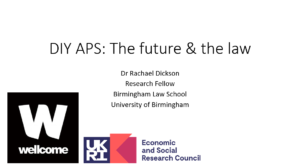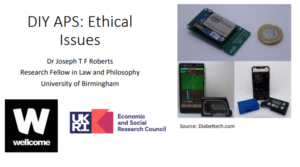2023
‘Software as a Medical Device: Living in a Material World?’
Presented by Muireann Quigley at:
Medical Law and Ethics Discussion Group, University of Oxford, 8th of February 2023
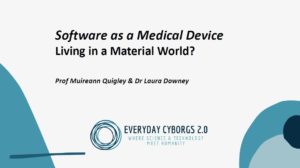
In recent years a range of attached and implanted medical devices have become, to greater or lesser degrees, ‘smart’. Many can store data and transfer that data to external repositories. Depending on the device’s particular capabilities, this could be via hard links, Bluetooth, Near Far Communication, or wifi. Significantly, these devices contain software enabling complex functionalities. Often, as with the example just given, medical device software comes integrated as part and parcel of a piece of hardware; that is, as software in a medical device (SiMD). Increasingly, however, software is being developed and made available independently of any particular device; to be downloaded and used, for instance, as an application (app) on a smart phone. Whilst there is much promise of improved care from such ‘smart’ medical devices, their complexity and risk profile present serious issues for regulators, developers, and end-users alike.
Of interest in this paper is the fact that there are a number of gaps and uncertainties regarding the application of the medical devices regulations in the case of software (as a medical device). These gaps and uncertainties are laid bare when we consider instances of open source (OS) software (as a medical device). Our contention is that many of the ambiguities and difficulties which we set out in this paper stem from the intangible nature of software. For us, this immateriality is rendered problematic within a body of law which has been predominantly constructed with (systems relating to) physical goods at its core. As such, using the example of open source automated insulin delivery systems as a case study, we examine how the law makes ‘matter’ matter and how software in general and SaMDs in particular challenge its material focus. Whilst we do not suggest wholesale solutions to the complexities identified, we make the case that the law should seek to make software ‘material’, and in so doing, bring it more comfortably within the existing legal and regulatory frameworks and systems.
2022
‘Integrating the Biological and the Technological: Time to Move Beyond Law’s Binaries?’
Presented by Muireann Quigley and Laura Downey at:
Hybrid Minds Research Group, 17th October 2022
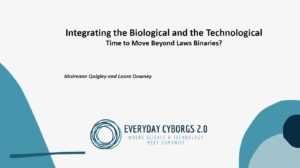
The common law takes a bounded approach to persons and objects: something is either a person (subject) or a thing (object), but not both. This conceptualisation of persons as bounded selves and objects as separate from persons represents an encumbrance that goes to the very heart of law. The person–thing binary is so fundamental that it both structures the law conceptually and dictates its practical applications. This chapter explores the consequences of this legacy in relation to ‘everyday cyborgs’ – that is, persons with attached and implanted medical devices. Drawing on Graeme Laurie’s work, it argues that recognising the inherent liminality of everyday cyborgs (and everyday cyborg technologies) allows us to look beyond law’s binaries more fully to account for the ‘spaces in-between’. The chapter finds that Laurie’s liminal analysis of law and his framework for processual regulation give us much needed analytical tools to begin to look beyond boundaries, beyond binaries and beyond bodies.
‘Taking Embodiment Seriously in Medical Practice and Health and Social Policy’
Presented by Joseph T F Roberts at :
Centre for Ethics in Medicine, University of Bristol, 20th October 2022
Mancept Workshops in Political Theory, University of Manchester, 7th September 2022
Centre for Biomedicine, Self, and Society, University of Edinburgh, 23rd June 2022
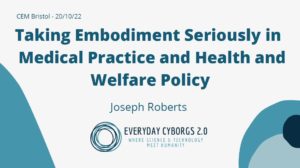
It is a common refrain in a certain brand of critical theorising that both liberal political philosophy and ethical theory pay insufficient attention to the fact that people are embodied. These charges are often directed at the disembodied and atomistic conception of the self that liberalism is said to presuppose. This failure to take embodiment seriously is no mere academic concern. Mark Flear, for example, argues that the harms caused by faulty medical implants have taken so long to come to light is due to the marginalisation of embodied experiences within the healthcare system.
In this paper I argue that, contrary to what is sometimes claimed, mainstream approaches to ethical theory and political philosophy which place importance on the values of autonomy, harm avoidance, and/or fairness are all implicitly committed to the importance of taking people’s embodiment seriously. Similarly, accounts of medicine which place value on healing are also committed to taking people’s first-person reports seriously to avoid misdiagnosis and ensure appropriate treatment, When it comes to taking embodiment seriously in public policy, however, there are harder challenges that need to be overcome. The first is that, given that there is an enormous amount of variation in how people are embodied, the question of how to allocate the benefits and burdens of policies across the population is unavoidable. The second challenge is based on the idea that, in public policy contexts, claims need to be verified to ensure that decisions fair, non-arbitrary, and based on serious deliberation. The challenge is finding ways to check the reliability of people’s testimony without perpetuating epistemic injustice
‘Emerging Legal Concepts and Law at the Intersection of Technology and Society: Authority, Legitimacy, and Legality’
Presented by Laura Downey at:
Society of Legal Scholars Conference, Kings College London, 7th September 2022
Advances in science and technology, from assisted reproduction and genetic therapies to the internet of things (IOT) have transformed contemporary life. Providing improved medical treatments, and creating new risks, such as threats to cybersecurity and the integrity of electronic devices, they also influence our understanding of the sociotechnical reality, social relations and practices, and their contingent values and moralities. For example, IVF and genetic modification change how and who can become parents, creating new familial relations and challenging what is possible (and permissible) by altering a person’s genetic make-up. Meanwhile, digital technologies have profoundly transformed communication and our integration with smart devices (including smart medical devices).
This paper explores the complex dynamics of legal change at the nexus between law and the sociotechnical environment. The critique that law often lags behind technology has been deepened and nuanced in law and technology literature, whilst the STS literature has developed a greater understanding of the relationship between technology and wider society. Despite this, there is a relative paucity in understanding how law and regulation develops as part of this broader sociotechnical change.
Using interdisciplinary insights including those in STS, the paper outlines an account of how new ideas in and about law develop. Specifically, it examines this process in the context of new health-related technologies. It posits that such emergence and change depend on competition and debate surrounding claims about, and perceptions of, the “authority”, “legitimacy”, and “legality” of particular concepts. In doing so, it explores some examples of past and potential future emerging concepts. It examines how entrenched features of legal structure, such as boundaries and binaries between persons and things, are being challenged. And it looks at how these features have the potential to shift in light of new technologies such as increasingly smart and integrated medical devices.
‘Visions of the Everyday Cyborg: Sociotechnical Imaginaries, Law and the Future of Medical Devices Regulation’
Presented by Rachael Dickson at:
Society of Legal Scholars Conference, Kings College London, 7th September 2022
Socio-Legal Studies Association Conference, University of York, 7th April 2022
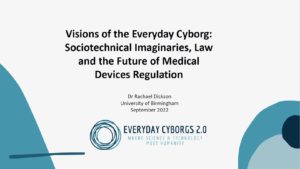
How the law ought to accommodate technological innovations in medical treatments is a debate that is not abating, especially as the UK Government is set to introduce new medical devices regulations in 2022. Medical devices are becoming ‘smarter’ (i.e. collecting, processing, and analysing data algorithmically), smaller, and further integrated with the human body. As such questions arise with regards to the position of such devices under the law. Are they merely property or part of the body? Who ought to bear rights over them and the data they generate? Who ought to have responsibility for ensuring their continued safety? The current law relating to medical devices focuses heavily on the role of device manufacturers, distributors, and clinical actors. The perspective of the person living with a device – who can be considered an ‘everyday cyborg’ – seems central to answering questions of how these technologies ought to be treated by law, regulated, and governed. Yet, this remains an under-explored avenue of inquiry within the current literature and public policy discussions.
This paper centres the lived experiences of ‘everyday cyborgs’ in relation to the law and regulation of attached and implanted medical devices. It presents empirical findings from a series of interviews and examines the techno-scientific futures that device users wish to materialise using the concept of sociotechnical imaginaries from Science and Technology Studies (STS). Further, the paper considers the legal changes that the visions of the future articulated by ‘everyday cyborgs’ may implore, examining structural issues within the existing legal and regulatory frameworks that may restrict possible legal futures. Emerging findings indicate an emphasis on empowerment and accessibility, autonomy and personalised approaches, and increased transparency, all of which challenge the current proprietary nature of commercial medical device development.
2021
‘Software as a Medical Device: Regulatory Gaps and Uncertainties?’
Presented by Laura Downey and Muireann Quigley at:
Centre for Ethics in Medicine, University of Bristol, 7th October 2021
Birmingham Law School Research Conference, University of Birmingham, 16th September 2021

Advances in information technology have resulted in increasingly “smart” medical devices that are capable of running software, lending these devices ever more complex functionalities. Often the relevant software comes as part and parcel of a physical medical device (e.g. a pacemaker or insulin pump). At other times, the software is developed and available independently of any particular devices; to be downloaded and used, for instance, as an app on a smart phone. There is no question that standalone software can be considered as a medical device in the eyes of the law, but the application of this law is far from clear or satisfactory in the age of digital medical devices.
In this paper, we set out some of the gaps and uncertainties regarding software as a medical device (SaMD). We make the case that the medical devices regulatory framework presupposes a model of medical device manufacture typical of hardware devices that software development – in particular open source software – models disrupt in a number of ways. For example, the collaborative, diffuse, global nature of some open source software leads to ambiguity in the application of key concepts in the medical device regulations. This includes determining at what point and whether software is “placed on the market”; identifying a legal “manufacturer”; and establishing whether certain forms of software – such as uncompiled code – fall within the definition of “medical device”.
We conclude that uncertainties in the application of the law stem from a bad regulatory “fit” between the framing of the Medical Device Regulations 2002 (and the EU Directives it implemented) around physical goods and the inherent intangibility of software. Given the increasing development and use of such software, this is something which needs to be addressed sooner rather than later.
‘Regulating DIY Artificial Pancreas Systems? On Citizen Science and Patient-led Innovation’
Presented by Rachael Dickson and Muireann Quigley
Socio-Legal Studies Association Conference, Cardiff University, 1st April 2021

This paper uses citizen science as a lens for analysing legal and regulatory challenges relating to the phenomenon of ‘looping’. Loopers are persons with diabetes who use open-source software installed on either a small computer/smartphones to construct DIY ‘artificial pancreas’ systems (APS) in order to better manage their diabetes. The software allows their continuous glucose monitor and insulin pump to ‘talk’ to each other, enabling insulin doses to be delivered automatically. Citizen science is “understood broadly as the participation of non-professionals at any phase of scientific research” (Fiske et al. 2019). Hitherto, most iterations of citizen science have centred on activities such as data collection, genetic sequencing, or developing biomarker tests. DIY APS, we argue, represent much more complex, treatment-oriented (and potentially problematic) examples of citizen science. The systems have been developed, designed, and adopted by non-medically trained citizens. Thus loopers represent a particularly concrete and tangible instantiation of the ‘citizen scientist’.
Drawing on citizen science literature we argue that DIY APS challenge and disrupt traditional medico-scientific models of treatment innovation. Correspondingly, since looping falls outside the usually tightly regulated medical device environment, it poses difficulties for the law and exposes gaps in the regulation of patient-led innovation. Unanswered questions include: Are those who create and use DIY systems liable for device malfunction? What impact does looping have on the responsibilities (legal and ethical) of clinicians towards loopers? And are such innovations adequately captured by the architecture of existing regulatory structures? We suggest that there are no easy answers to these questions. Whilst DIY APS generally represent a welcome democratisation of diabetes management, as examples of citizen science par excellence, they trouble the usual knowledge and power dynamics of medico-scientific innovation. This has potentially profound implications for the effective governance of the growing use of these largely unregulated medical technologies.
‘Being Novel? Regulating Emerging Technologies Under Conditions of Uncertainty’
Presented by Joseph TF Roberts and Muireann Quigley at:
Max Planck Institute for Social Law and Social Policy, Webinar, 23rd February 2021
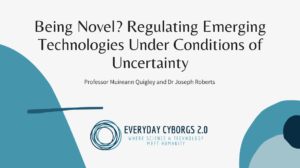
If we accept that at some point novel beings – be they synthetic, biological, or biohybrid in nature – will be brought into existence, then we need to consider how the law should take account of (the emergence of) such beings. This is a sticky problem, because any attempt to engage in preparatory regulation with respect to novel beings is mired in uncertainty. Principally, this uncertainty relates to the fact that there is a large – perhaps insurmountable -epistemic gap when it comes to all manner of (legally and morally) significant facts about novel beings. Put simply, we do not know what type of beings they will be, either in terms of their physical nature/embodiment or mental/cognitive characteristics. Neither do we know, as McKeown has put it, ‘how their corporeality shapes their options, preferences, values, and is constitutive of their moral universe’ (McKeown 2020, p. 1). Essentially this means that, as these beings do not yet exist, we do not have access to the relevant context-dependent information needed to propose a detailed regulatory regime.
In light of these epistemic difficulties and uncertainties, in this presentation we do not propose a detailed account of law and regulation for novel beings. Instead we outline a range of normative principles which could help guide the regulation of precursor technologies without undermining our ability to appropriately regulate emerging novel beings in the future. By precursor technologies, we mean those technologies which exist now, but which are likely to serve as important stepping stones to the eventual emergence of particular novel beings. In this respect, we focus on digital-based task-specific expert systems as potential precursors to the kinds of advanced artificial general intelligences (AGIs) which would qualify as novel beings possessing moral status.
2020
‘DIY APS: The Future & the Law’
Presented by Rachael Dickson at:
Danish Diabetes Academy, Webinar, 16th December 2020
Recent years have seen commercial manufacturers of medical devices take their first steps into manufacturing hybrid-closed loop artificial pancreas systems. Whereas once this technology was the preserve of the #WeAreNotWaiting movement, there are now multiple commercial systems on the market.
One of the problems with DIY APS systems is that they are mired in legal uncertainty. Unlike DIY alternatives, commercial systems have been through the approval process required to receive market authorisation. As there is less legal uncertainty surrounding commercial systems, we might expect to see a shift away from DIY APS. In this presentation I explore four reasons why the presence of commercial systems will not necessarily resolve these legal uncertainties.
First, just because commercial systems have been granted market authorisation, that does not mean everyone who wishes to use them will be able to do so. This can occur because not all NHS trusts will fund commercial artificial pancreas systems and they are expensive to purchase privately. Secondly, as commercial manufacturers have to get approval for their devices, innovations can take longer to get to market than DIY alternatives which developed on an open-source model. In that time DIY APS systems may have incorporated new features; making them a more attractive option for some users.
Thirdly, DIY APS users are now experts on artificial pancreas systems. Without training for clinicians on how to support people using commercial systems individuals who are currently using DIY APS may be reluctant to move to a commercial system. Finally, many DIY APS users value the community surrounding the technology. The DIY APS community is a space where users can ask for advice from peers who are also using the system. The community’s assistance is not purely technical but also includes lifestyle advice and empathetic emotional support for people living with diabetes. If this support is not forthcoming from clinicians, DIY APS users may be reluctant to move on to a commercial system.
‘DIY Artificial Pancreas Systems: Ethical Issues‘
Presented by Joseph TF Roberts at:
Advanced Technologies & Treatments for Diabetes (ATTD) Madrid, 20th February 2020
The increasing use of DIY APS raises a series of ethical and legal problems including: ensuring patient safety, protecting privacy and preventing unauthorised access, determining liability for harms should the system fail and maintaining trust in the doctor patient relationship.
At the moment in the UK clinicians adopt a precautionary approach to discussing DIY APS with their patients in the clinic. Clinicians are currently advised not to initiate conversations about DIY APS. However, if the patient raises the issue, clinicians should inform their patients it is an unregulated medical device, the known risks of using it, and inform them that they use the device at their own risk.
In this talk I argued that this policy has the potential to undermine trust in the doctor patient relationship. Relationships of trust are built on honest and open communication. If clinicians fail to discuss potentially beneficial technologies and patients find out about them through alternative means (such as internet searches or patient support groups), they may come to distrust their clinicians for withholding information from them. If we want to maintain trust in the doctor patient relationship it is imperative that clinicians can have honest and open conversations with their patients. To do that, they may need to be able to initiate conversations about DIY APS in some instances.
‘Citizen Science and DIY Diabetes – Ethical and Regulatory Challenges of Patient-led Innovation’
Presented by Rachael Dickson and Muireann Quigley at:
Centre for Health Law Science and Policy, University of Birmingham, 11th February 2020
School of Law, Queens University Belfast, 19th February 2020

Healthcare technology innovation in diabetes management is a slow process, resulting in a community of ‘loopers’ emerging. Tired of waiting for commercial companies to produce effective, accessible products, loopers are constructing DIY ‘artificial pancreas’ systems (APS) to better manage their diabetes by connecting their insulin pumps to their glucose monitors using either a small computer or their smartphones.
In this paper we problematize and analyse the DIY diabetes movement as an aspect of ‘citizen science’. Citizen science is “understood broadly as the participation of non-professionals at any phase of scientific research” (Fiske et al. 2019). The types of activities captured by citizen science include “include volunteer monitoring, community science, and participatory research . . . [as well as] technology-supported projects where crowdsourcing techniques [which] are applied to scientific data or analysis” (Wiggins & Willbanks 2015).
Up until now, most discussions regarding citizen science have often focused on areas such as genomics, where citizen scientists are involved in genetic sequencing or working towards creating biomarker-based tests for rare diseases, or data collection, where the patients are leading projects to improve understanding of particular health conditions. In a number of respects DIY APS represents a much more complex, treatment-oriented (and potentially problematic) example of citizen science. Using citizen science as a lens for enquiry, in this paper we explore some potential ethical and regulatory challenges of patient-led innovation. We argue that while DIY APS generally represents a welcome democratisation of diabetes management, there are a number of pressing concerns which need to be addressed regarding the growing use of an essentially unregulated medical technology.

